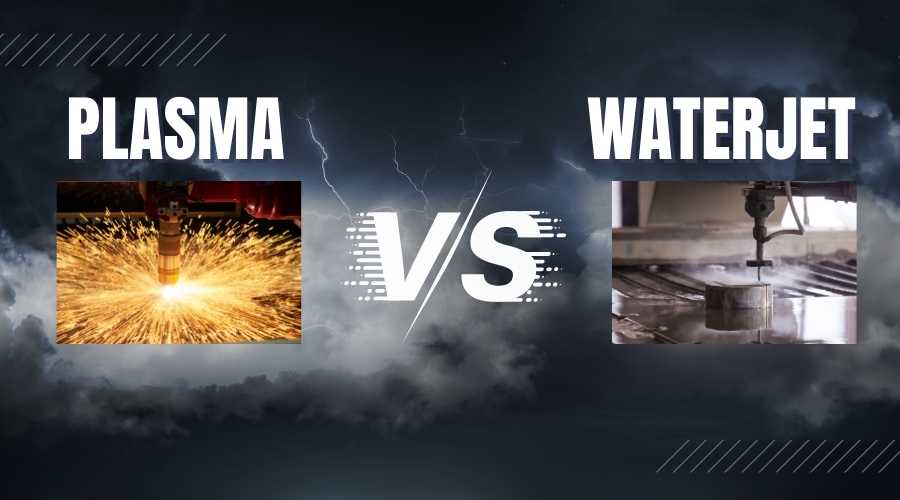In this post, we’ll look at CNC plasma vs waterjet cutting. Both are popular and precise methods of cutting and shaping materials. But which is better for your needs? That’s what I’ll be covering in this guide.
Let’s dive in.
Cutting Technology
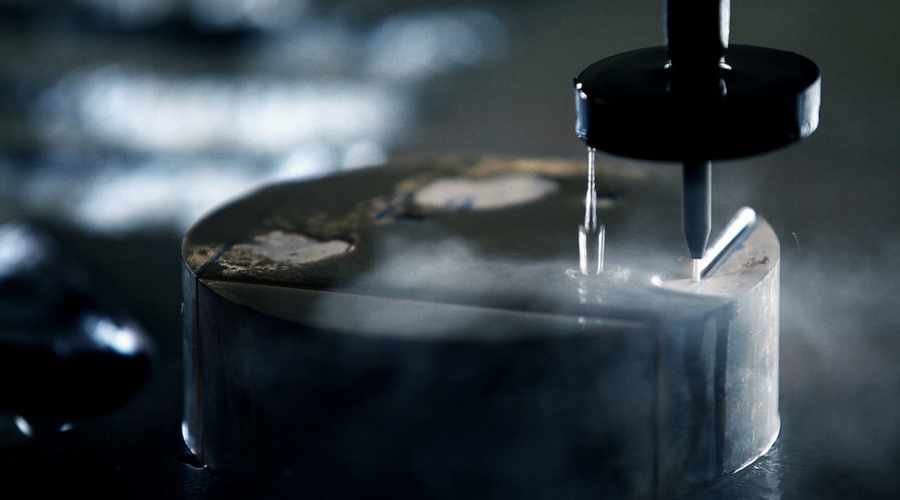
CNC plasma cutting uses a plasma torch to cut through materials by shooting a high-velocity stream of inert gas out of a nozzle, via an electrical arc, which is converted to plasma.
This superheated plasma cuts at high speeds through most conductive metals, but works really well with steel up to 3” thick.
Waterjet cutting, on the other hand, uses a high-pressure stream of water and an abrasive, such as garnet, to cut through a wide range of materials.
The water is pressurized to around 60,000 to 90,000 pounds per inch (psi). The stream can cut through materials like stone, ceramics, metal, glass and more.
Some waterjet cutters, known as pure waterjet cutters, are best for softer materials, as they do not use abrasive. Instead, these rely on only the supersonic steam of water to cut and erode the material.
In both cases, we’re using computer numerical control (CNC) technology to guide the cutting process.
Cutting Speed
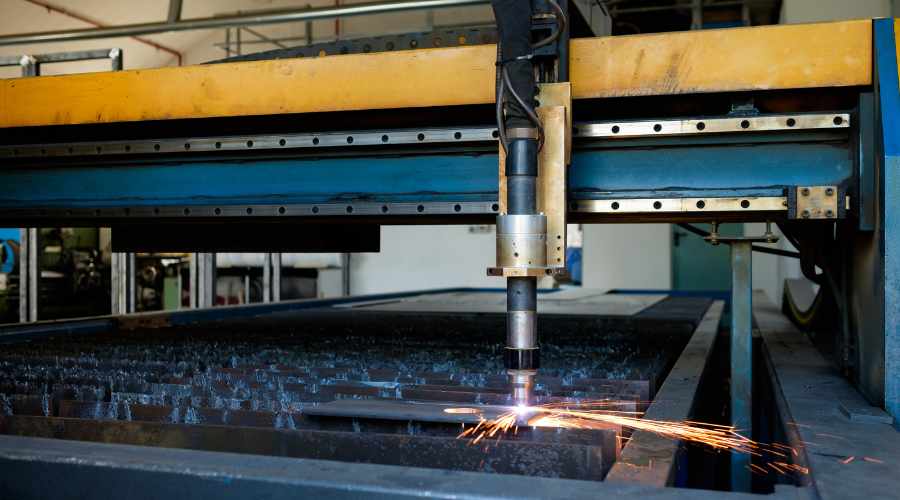
When we’re talking about cutting speed with plasma and waterjet cutters, we’re comparing traverse speeds in inches per minute (ipm).
Of course, the right speed really depends on the type and thickness of the material you’re cutting. And fast isn’t always better.
For example, with waterjet cutting, using finer abrasives at a slower speed produces a smoother surface compared to cutting with coarser abrasives at high speeds. It all depends on the desired outcome.
With that out of the way, CNC plasma cutting is generally faster than waterjet cutting.
Plasma cutters can average around 1000 ipm max cutting speed, while waterjet cutters have max cutting speeds from around 100 to 600 ipm.
In both cases, the max speed varies greatly by the type, size, and quality of machine, along with the materials and design objectives.
Material Compatibility and Thickness
Here’s one area where waterjet technology excels (in both the range of and thickness of materials it can cut).
CNC plasma cutting is best suited for cutting conductive materials, such as metal, and is not effective when cutting non-conductive materials, such as plastic, wood, or ceramics.
Waterjet cutting, on the other hand, can cut through a much wider range of materials, including both conductive metals and non-conductive materials such as ceramics, marble, stone, and more. But it doesn’t work as well with very hard or brittle materials.
Also, since waterjet cutting is not a hot process, it can cut through heat-sensitive materials like rubber, plastics, and composites without producing fumes or causing thermal damage.
Waterjets can also cut much thicker materials than plasma cutters. Most CNC plasma cutters have a maximum cutting thickness of 1”, although some industrial quality machines can cut up to 4”.
However, many waterjet cutters can cut materials up to 10” thick. And that’s with a stream of .5 mm to 1.3 mm.
Precision and Finish
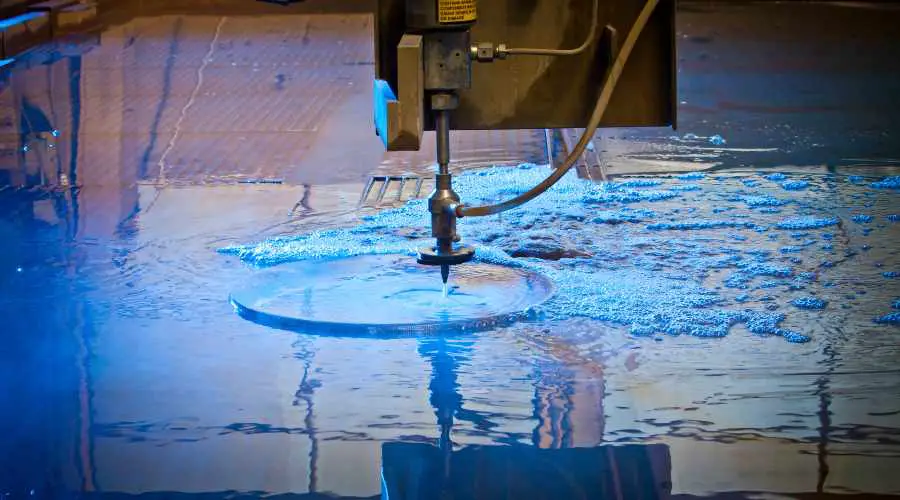
Let’s be honest, both CNC plasma cutting and waterjet are advanced processes that can produce some very fine and precise cuts. But waterjet is generally more accurate.
For example, a waterjet can produce cuts with tolerances of around +/- .003 inches or better, while plasma cutting typically has tolerances of around +/- .020 inches.
For many makers, this level of comparison is really getting into the weeds, and differences at this finite level might not really matter. But for manufacturers who work with tight tolerance specs, this is where waterjet cutting can shine.
Also, waterjet cutting tends to produce a smoother cut. As mentioned, this is due to the ability to cut at slow speeds with fine abrasives that actually smooth edges as they erode the material.
Plasma cutters tend to produce a rougher finish due to the high temperatures used in the cutting process.
Cost
Cost is one of the main differentiators when comparing plasma and waterjet cutters.
CNC plasma cutting systems can range in price from around $10,000 to $100,000 or more, depending on the size and capabilities of the machine.
But there are many high-quality entry-level plasma tables that can be found near or below the bottom of that price range. This makes plasma cutters a viable option for small business owners and even hobbyist makers.
For example, the 4×8 Nitro CNC plasma table from TrackerCNC starts at $12,995.00. And you can even find several 5×10 CNC plasma models with industrial-level components for less than $20,000.
Waterjet cutters are generally more expensive than CNC plasma cutting systems, with prices ranging from around $60,000 to $500,000 and more.
Keep in mind, these are usually bigger, heavier systems that are designed for commercial manufacturing. But even used waterjet cutting systems will start around $50,000, although you can definitely find bargains when looking at demo and tradeshow models. It just takes some digging.
Interestingly, for small shops and makers, there are some new desktop waterjet models that come in around the $10,000 mark, such as the Wazer.
Safety and Operations
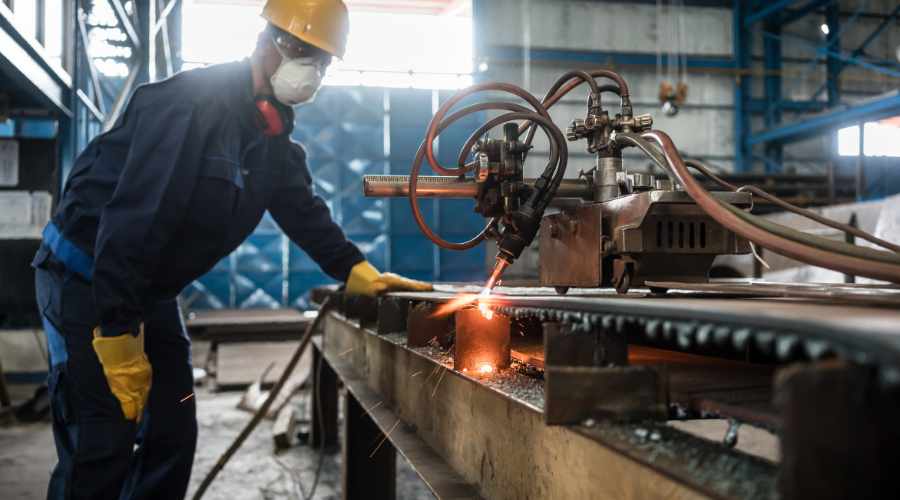
Overall, both CNC plasma and waterjet cutting are safe methods of cutting materials if the proper safety precautions are followed. However, there are still some differences in the potential safety hazards associated with each.
First, waterjet cutting is not a hot process, so there are fewer health and safety issues when it comes to fumes, gas, and flammability.
For example, the heat generated by plasma cutters is “hotter than the surface of the sun” and can exceed temperatures of 45,000° F, which of course presents some safety concerns.
Also, the gas used and produced during cutting can be harmful, so manufacturers often suggest wearing appropriate personal protective equipment (PPE) and ensuring the cutting area is well-ventilated when working.
Operators should also consider that the torch uses an electrical current that can cause electric shock if you come in direct contact with these components during use.
Of course, waterjet cutting is not without its own set of risks.
First, waterjet systems use extremely high-pressure steams and, usually, an abrasive material. These could cause serious injuries if you’re not careful and come in contact with the cutting stream. Also, users must consider the possibility of flying debris when using a waterjet cutter.
Finally, these machines can produce very high levels of noise, even exceeding the acceptable levels in certain environments and causing hearing damage if proper protection isn’t worn.
To minimize these risks, it’s best to wear appropriate PPE, such as safety glasses and ear plugs, and ensuring that the cutting areas are properly shielded to contain high-pressure water and abrasive material.
Maintenance
While it’s fun to talk about cutting speeds, materials, and performance, we can’t forget about maintenance. And any high-caliber CNC cutting machine is going to require regular maintenance to make sure they operate at optimal performance and to extend its lifespan.
Also, the specific requirements for each machine will vary depending on the make and model of the equipment, as well as the usage patterns and operating conditions.
But there are some key differences in the general maintenance needs with CNC plasma cutters vs waterjet cutters.
With plasma machines, you need to make sure you clean them regularly to remove any dust, debris, or other contaminants that can build up on the machine and affect performance.
Also, the plasma torch should be checked and maintained regularly to ensure it’s functioning properly and to replace consumables, including electrodes and plasma gas supply, as needed.
You should also regularly check the electrical components as well as the gas system to make sure flow is consistent and to replace any damaged or worn parts.
But regular cleaning and maintenance are not unique to plasma cutters. You also need to clean waterjet equipment regularly to remove dust and debris. And you will also need to keep an eye on the nozzle to ensure it is functioning properly, and to replace consumables such as orifices and mixing tubes.
You also have to maintain the high-pressure pump, change the waterjet tank frequently, and check and replenish the abrasive material regularly.
The bottom line, neither of these are low-maintenance machines. But that’s a small price to pay for the long-term performance you get with proper cleaning, maintenance, and care.
Applications
Both CNC plasma cutters and waterjet cutters are used in a wide range of industry applications, including manufacturing, metal fabrication, construction, aerospace, automotive, shipbuilding, and more.
Plasma cutting is mostly used to cut and shape metal parts for a variety of applications, such as automotive and aerospace components, structural steel and machine parts. For example, in the construction industry, plasma cutters are used to cut and shape building components, such as beams, columns, and brackets.
And DIY enthusiasts can also take advantage of the metal cutting performance gained by using a CNC plasma cutter. You’ll find makers using plasma cutters to make home items, gates, railings, decorative artwork, signs, custom fire pit enclosures, and much more.
Just take a look at this custom fire pit made with a Torchmate plasma cutting table for some inspiration.
Waterjet cutting is ideal for manufacturing a wider range of materials with a broader spectrum of thickness. You’ll find waterjet cutters used to cut stone, plastic, glass, metal and more, to shape and fabricate automotive parts, aerospace components, and medical devices.
These machines are frequently used in the stone and tile industry to cut and shape natural and artificial stone, such as granite, marble, and ceramic, for countertops, flooring, and several other decorative applications.
For example, take a look at this custom marble design made with a CNC waterjet.
CNC Plasma vs Waterjet: Comparison Summary
CNC plasma and waterjet cutting are both excellent options for seeing your designs come to life with fast, accurate and clean cuts.
But there are clearly some key differences between the two.
To summarize:
- Waterjets do not require heat to operate and therefore do not cause thermal damage.
- They can cut almost any type of material, including metals, stone, plastic, composites, and much more.
- Waterjet cutters can cut thicker materials than a plasma cutter with better accuracy and smoother finishes.
- However, plasma cutters are less expensive and more accessible for smaller businesses and single operators.
- They work exceptionally well on most metals, including stainless steel, and can be used on thinner metals with faster cutting speeds than waterjet machines.
Deciding which one is right for your business depends on several factors, including your budget, space, and the types of materials you’ll be working with.
